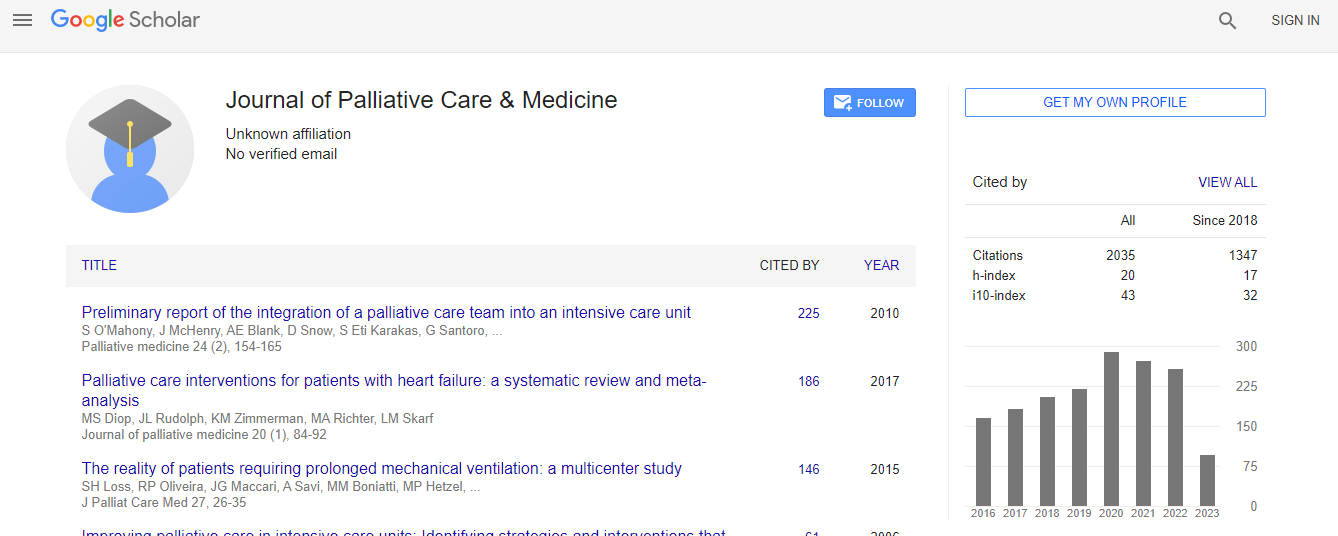Our Group organises 3000+ Global Conferenceseries Events every year across USA, Europe & Asia with support from 1000 more scientific Societies and Publishes 700+ Open Access Journals which contains over 50000 eminent personalities, reputed scientists as editorial board members.
Open Access Journals gaining more Readers and Citations
700 Journals and 15,000,000 Readers Each Journal is getting 25,000+ Readers
Recommended Conferences
42nd Global Conference on Nursing Care & Patient Safety
Toronto, CanadaGoogle Scholar citation report
Citations : 2035
Journal of Palliative Care & Medicine received 2035 citations as per Google Scholar report
Journal of Palliative Care & Medicine peer review process verified at publons
Indexed In
- Index Copernicus
- Google Scholar
- Open J Gate
- Genamics JournalSeek
- China National Knowledge Infrastructure (CNKI)
- Electronic Journals Library
- RefSeek
- Hamdard University
- EBSCO A-Z
- OCLC- WorldCat
- Virtual Library of Biology (vifabio)
- Publons
- Geneva Foundation for Medical Education and Research
- Euro Pub
- ICMJE
Useful Links
Recommended Journals
Related Subjects
Share This Page
Is there a relationship between atherosclerosis indices and mitral regurgitation in patients with mitral annular calcification?
10th International Conference on Internal Medicine & Patient Care
Ferhat Dindas
Usak University,Turkey
ScientificTracks Abstracts: J Palliat Care Med
Abstract
The most common accompanying valve disease of mitral annular calcification (MAC) is mitral regurgitation (MR). The relationship between the presence of mitral regurgitation and MAC burden has been tried to be clarified by many theories. It could not go beyond the presence of mitral valve coaptation defect and atherosclerotic load. The aim of this study is to compare atherosclerotic indices according to MR severity in MAC patients. Our retrospective cross-sectional observational study included 587 consecutive patients who applied to the cardiology clinic and underwent echocardiography between 2008 and 2020. A total of 71 patients who received lipid-lowering therapy within six months without echocardiography and who had an incomplete echocardiography report were excluded from the study. The remaining 516 patients were divided into two groups according to the presence of MR. Basic biochemical parameters, echocardiographic parameters, and atherosclerosis-related indices of 360 patients with MR and 156 patients without MR were compared. The Atherogenic indexes were calculated as follows (1): Atherogenic Index of Plasma (AIP) = log (TG / HDL-c) Atherogenic Coefficient (AC) = (Total cholesterol ├ó┬?┬? HDL-c) / HDL-c Castelli├ó┬?┬?s Risk Index (CRI-II) = Total cholesterol / HDL-c Castelli├ó┬?┬?s Risk Index (CRI-II) = LDL-c / HDL-c Among the echocardiographic parameters, the presence of aortic and tricuspid insufficiency, biatrial dilatation, and ventricular hypertrophy were significantly higher in the MR group (all p values <0.05). Hemogram and LDL-c, which are basic blood parameters, were significantly lower in the MR group (all p values <0.05). Among the atherosclerosis-related indices, AIP, AC, CRI-I and CRI-II, did not differ between the groups (all p values >0.05). Although MAC most commonly causes mitral regurgitation, it has a poorly defined pathogenesis (2). It has been tried to explain that the sphincter effect caused by MAC and the traction that occurs in the chordae leads to MR (2). Even if the underlying lipid accumulation indicates an atherosclerotic process, the presence of macrocalcification and bony formations in the biopsies taken away from the ordinary atherosclerotic process (3). In conclusion, the pathogenesis of MR in MAC patients does not seem to be related only to atherosclerosis, but the management of MAC patients may be facilitated by adding additional theories in future studies.Biography
Ferhat Dinda├?┬?, MD, PhD is an interventional cardiologist and assistant professor at U├?┬?ak Training and Research Hospital. He has experience in the field of percutaneous intracranial thrombectomy in the management of stroke patients with carotid artery atherosclerosis. Percutaneous valve implantation is the area where he wants to improve himself.

 Spanish
Spanish  Chinese
Chinese  Russian
Russian  German
German  French
French  Japanese
Japanese  Portuguese
Portuguese  Hindi
Hindi 
